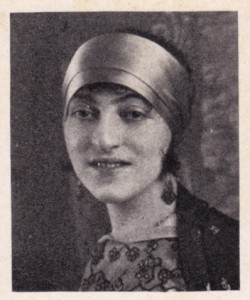Mayn mamen – audio
English follows Yiddish.
מלכּה לי (1904־1976)
(פּסעװדאָנים פֿון מלכּה לעאָפּאָלד־ראַפּאַפּאָרט) איז געבױרן געװאָרן אין מאָנאַסטרישטש, מיזרח־גאַליציע אין אַ חסידישער משפּחה. בעת דער מלחמה איז זי מיט דער משפּחה פֿאַרװאָגלט געװאָרן קײן אונגערן און דערנאָך װין װוּ זי האָט געלעבט ביז 1918. זי האָט זיך געלערנט אין אַ פּױלישער פֿאָלקשול און גימנאַזיע. אָנגעהױבן שרײַבן לידער האָט זי אױף דײַטש אָבער אין 1921, דאָס יאָר װאָס זי האָט אױסגעװאַנדערט קײן אַמעריקע, איז זי אַריבער צו ייִדיש. אין 1922 האָט זי דעביוטירט אין די פֿעדער, נ“י, און זינט דעמאָלט האָט זי זיך באַטײליקט מיט לידער, דערצײלונגען און מעמואַרן אין אַ סך צײַטונגען און זשורנאַלן, צװישן אַנדערע: פֿרײַע אַרבעטער שטימע, פֿרײַהײט, צוקונפֿט, טאָג־מאָרגן־זשורנאַל, אידישע קעמפֿער, די גאָלדענע קײט און קינדער־זשורנאַל.
זי און איר ערשטער מאַן, דער שרײַבער אַהרן ראַפּאַפּאָרט, זײַנען געװען באַלעבאַטים פֿון אַ באָנגעלאָ־קאָלאָניע אין הײַ פֿאָלס, נ“י, װוּ אַ גרופּע ייִדיש־אינטעלעקטואַלן פֿלעגט זיך צונױפֿקומען אױף דאַטשע. לױט דער ענציקלאָפעדיע פֿון ייִדישע פֿרויען אין אַמעריקע J[Jewish Women in America: An Historical Encyclopedia], „איר װערק שטעלט מיט זיך פֿאָר אַ גאַנצן דור ייִדישע פֿרױען, געבױרן און דערצױגן געװאָרן אין מיזרח־אײראָפּע בײַם אָנהײב 20סטן יאָרהונדערט, װאָס האָבן געפֿונען זײער אַן אַנדער לעבן אין אַמעריקע. איר פֿריִיִקע פּאָעזיע פֿלעכט צוזאַמען זכרונות פֿון דעם לעבן אין שטעטל אין אַ חסידישער משפּחה מיט די איבערלעבונגען פֿון דער װעלטלעכער אימיגראַנטישער תּקופֿה. אירע בענד אַרױסגעגעבן צװישן 1945 און 1950 שפּיגלען אָפּ דעם פּערזענלעכן װײ פֿון איינעם װאָס האָט פֿאַרלאָרן איר משפּחה און די הײם פֿון אירע קינדער־יאָרן כאָטש זי איז פֿון דער זיכערער װײַטער אַמעריקע געווען בלויז אַ צוקוקער צו דער טראַגעדיע. איר שפּעטערדיקע אַרבעט דריקט אױס אַ ליבע צו דער נאַטור און איר צוגעבונדנקײט צו אַמעריקע, װי אױך איר ציוניסטישע איבערגעגעבנקײט מדינות־ייִסראָעל.
מלכּה לי האָט אַרױסגעגעבן 6 בענד פּאָעזיע: לידער, 1932, געזאַנגען, 1940, קינות פֿון אונדזער צײַט, 1945, דורך לױטערע קװאַלן, 1950, אין ליכט פֿון דורות, 1961, אונטערן נוסנבױם, 1969 װי אױך אירע זכרונות: דורך קינדערשע אױגן, 1955 און אַ ביכל דערצײלונגען און משלים פֿאַר קינדער, מעשׂהלעך פֿאַר יאָסעלען, 1969.
אַ דאַנק חנה בערמאַן און בעלאַ סאַנדערסאָן פֿון טאָראָנטע וואָס האָבן מיר צוגעשיקט דאַס ליד און זייער איבערזעצונג וואָס זיי האָבן צוגעגרייט אויף זייער מאַמעס לוויה.
מײַן מאַמען
איך שפּין אױס אַ צירונגשנור פֿאַר דיר,
פֿון אַלע מײַנע טעג און יאָרן.
מאַמע מײַנע, איך שפּיגל זיך אין דיר,
װי זון אין אַ קװאַל אַ קלאָרן.
װען מײַן טאָכטער אין װעג זיך גרײט,
שטײט דײַן פּנים איר צוקאָפּנס.
איך זאַמל אײַן דײַנע רײד,
װי זאַנגען גאָלדענע אין סנאָפּעס.
דײַן יעדעס װאָרט אין מיר פֿאַרפֿלאַנצט,
דורך יאָרן רײַפֿע, טיפֿער זײ באַנומען.
דאָס װאָס איך האָב נישט דערגאַנצט —
אין מײַנע קינדער אַרײַנגעשפּונען.
דײַן גוטסקײט, דײַן שײנקײט פֿון דײַן זײַן,
אין מײַנע אָדערן געפֿלאָסן —
האָב איך, װי גוטן רױטן װײַן,
אין כּלים גאָלדענע איבערגעגאָסן.
אין ליכט פֿון דורות, 1961
MAYN MAMEN
Ikh shpin oys a tsirungshnur far dir,
Fun ale mayne teg un yorn.
Mame mayne, ikh shpigl zikh in dir,
Vi zun in a kval a klorn.
Ven mayn tokhter in veg zikh greyt,
Shteyt dayn ponem ir tsukopns.
Ikh zaml ayn dayne reyd,
Vi zangen goldene in snopes.
Dayn yedes vort in mir farflantst,
Durkh yorn rayfe, tifer zey banumen.
Dos vos ikh hob nisht dergantst –
In mayne kinder arayngeshpunen.
Dayn gutskeyt, dayn sheynkeyt fun dayn zayn,
In mayne odern geflosn –
Hob ikh, vi gutn roytn vayn,
In keylim goldene ibergegosn.
In likht fun doyres, 1961
Malka Lee (1904-1976)
(pseudonym of Malka Leopold-Rappaport) was born in Monastrikh, Eastern Galicia into a Hasidic home. During the World War I she and her family fled to Hungary and then to Vienna where they lived until 1918. She studied in a Polish elementary and high school. She began writing poetry in German but in 1921, the year she emigrated to New York, she turned to Yiddish. In 1922 she made her literary debut in Di feder, NY, and after that she contributed poems, stories and memoirs to many newspapers and magazines including: Fraye arbeter shtime, Frayheyt, Tsukunft, Tog-morgn-zhurnal, Idishe kemfer, Di goldene keyt and Kinder-zhurnal.
She and her first husband, the Yiddish write Aaron Rappaport, owned and operated a bungalow colony in High Falls, New York which became a haven for Yiddish intellectuals based in New York. According to Jewish Women in America: An Historical Encyclopedia, Lee’s work “is representative of an entire generation of Jewish women born and educated in Eastern Europe at the beginning of the twentieth century who found a very different life in America. Her early poetry intertwines the memories of shtetl life in a Hasidic family with the realities of the secular immigrant experience. Her volumes published between 1945 and 1950 reflect the personal pain of observing the Holocaust, with its destruction of family and childhood home, from the safety of distance in America. Her later work expresses a love of nature and attachment to America, as well as her Zionist devotion to the State of Israel.”
Lee published 6 volumes of poetry: Lider (Poems), 1932, Gezangen (Songs), 1940, Kines fun undzer tsayt (Lamentations of our times), 1945, Durkh loytere kvaln (Through pure springs), 1950, In likht fun doyres (In the light of generations), 1961, Untern nusnboym (Under the nut tree), 1969 as well as her memoirs Durkh kindershe oygn (Through childish eyes), 1955 and a children’s book Mayselekh far Yoselen (Stories for Yosele), 1969.
To My Mother
I spin a string of jewels for you
Of all my days and years.
My mother, I am mirrored in you
Like sun in a clear spring.
When my daughter prepares for her journey
Your image stands before her.
I gather in your words
Like sheaves of golden stalks.
Your every word is implanted in me,
The ripening years deepened my perceptions.
That which I did not complete
I wove into my children.
Your goodness, the beauty of your being,
Flowed through my veins –
And so, as with good claret,
I decanted it into golden goblets.
Translated by Ana Berman and Bella Sanderson on the occasion of their mother’s funeral.

